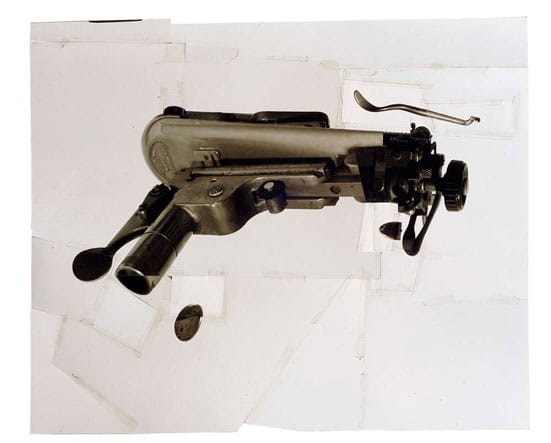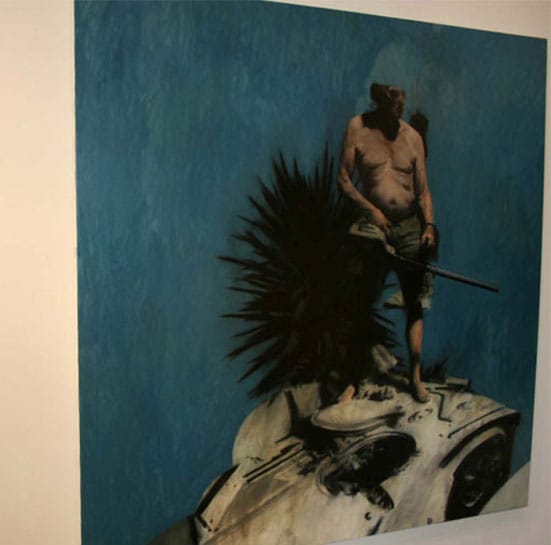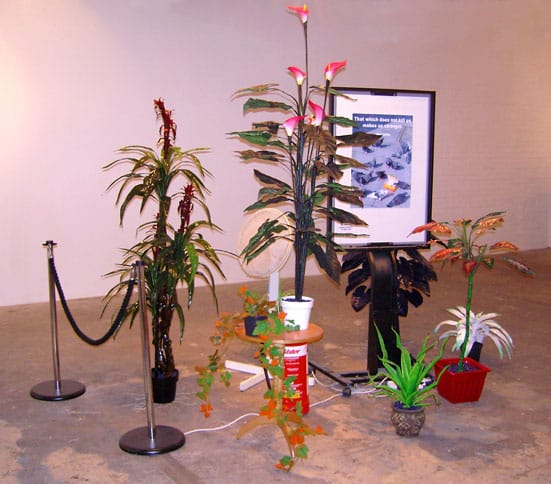Urge Ourselves Under - Warren Carvery, Thomas Meissner, Toren Schvantzi and Adrian Lee
Five Hundred Dollars, 12 Vyner Street, E2 9DG
15 October – 6 November 2009
Open late Thursday 5 November, as part of Time Out's First Thursdays.
Rose Lejeune: You are currently exhibiting in the exhibition, Urge Ourselves Under, at Five Hundred Dollars as under three different pseudonyms. Could you explain a little bit about the genesis of the exhibition: your work in it, why you chose to not exhibit under your own name and invite Adrian Lee to also exhibit with you.
Phil Hale: Working under pseudonyms, and as such dividing the space up between a series of different artist, came from... well, partly at least a lack of time for setting up the show – having spent so much time setting the space up, there was very little left to develop the work. I had to work inside paths that were already familiar... also working anonymously becomes a liberating process. It wouldn't seem so possible to make, for example, the death-metal-esque black heads as 'Phil Hale' but under another name it becomes possible to explore some stupider areas without the same accountability. And something worthwhile shows up despite yourself.
With more time, and working under one's own name would force a more controlling approach that wasn't possible in the time-but also wouldn't have allowed for these new explorations.
The impetus for setting up the space came from the desire to make new work, feeling like it was time for a new show and wanting to break free from portraiture. I needed a date and an obligation.
The masks, started as exercises, something to do every day, in a single sitting. By focusing on the same thing every day (the same basic structure), I was able to pay complete attention to the micro-elements, the only elements that really interested me- that is, all the variables are fixed but one, and something new is able to come into view from that microscoping. This is furthered by working with such a redundant, trashy aesthetic, a bankrupt and valueless iconography as a starting point so there's a sense in which what starts off as a valueless iconography becomes a place within which new processes and mutations become possible.
The decision to invite Adrian Lee was based on an idea that his work would somehow fit into the space but also that there was a synergy and cohesion between our practices in terms of their objecthood and precisely his ability to focus on a single idea and take it to its' absurd end point. I identified with this ability to block everything else out, and also hoped that it would inject something witty into the exhibition. Adrian's work represents a chaos in the centre that acts as a counter-point to and punctuation of the dense pockets of taste and over-management that exist around the outside.
RL: You are also a co-director of Five Hundred Dollars, can you about how you view the act of curating, of inviting artists to work with you – both in terms of this show and the invitation to Adrian abut also your programme in a broader sense.
PH: Curating shows with established artists whereby they're invited to exhibit anonymously means that they are able to do something that they might not do otherwise -. There is a danger here, of course that this could be mis-interpreted as them exhibiting work that has been sitting at the back of a cupboard – and the show degenerates into a kind of jumble-sale. You hope everyone sees the opportunity and wants it.
For me, you should be able to see the tone of the artist through the works, there needs to be a structure and a feeling. I don't want people to be looking at the show and aware that they're in an art gallery; thinking 'I'm in an art gallery and those are the pictures that I'm looking at' in that kind of conscious way ...
RL: And what kind of reception have you had to the show?
I haven't paid much attention, happy to have it up and intact – it's a likable show, accessible – which could be seen as a drawback but I think it's an insignificant show done to perfection, not a 35% of an astonishing show.
I liked that the work was done so quickly in the end – the work was literally lying on my sofa in the studio a couple of days before and it looked so good that we just decided to put the sofa on display – Adam just did it – put it up on the wall – a fabulous willingness and enthusiasm on his part to make it happen.
RL: Can you tell me a little bit about the gallery?
PH: We're very lucky with the space, we're not beholden to commissions, we don't need to make sales, the Jerwood pays most of the rent ... For me, then, the space gives me a way of creating new connections - of stretching and forging relationships but also, more it gives me a reason to make work in the first place. You only learn – I only learn – through making new work; through stretching myself – I know that sounds embarrassingly earnest, but if you're not excited by what you're doing, you can't pay attention properly, you're not learning. The space has given me a place for something to happen.
RL: So, what's next?
PH: This is the last exhibition of Five hundred Dollars at this space – we're moving to a space close by and will re-open in the New Year. There'll be a slightly different structure and set up – for example, the people who are currently working at the space will start to take more ownership of it and I'll be passing much of the organisational and direct curatorial ownership onto them. Also, we want to experiment with different ways of giving audiences access to the work and the artists we work with – for example, we're going to make a documentary film of every exhibition – something that gives a sense of the process but is make by a film-maker with an agenda – not some kind of BBC fly-on-the-wall thing, more an additional work to support the overall structure and give the audience another opportunity to find out information, another point of view.
RL: And, finally, why is it called Five Hundred Dollars?
PH: We wanted a neutral name, to create a neutral place, where I could invite people to make their own space. Five Hundred Dollars is an insignificant amount of money, you'd be pissed off if you lost it, but it's not going to change your life. It also, linguistically, disappears very quickly, as soon as you've said it once, its repetition turns it quickly into a Name – but without it being crazily singular in a fetishistic way. Of course, it is American, which is a loss.
Rose Lejeune

Warren Carvery
Photographic Collages
Various Sizes.
2009

Warren Carvery
Photographic Collages -detail
Various Sizes.
2009

Thomas Meissner
'Males and Females'
Oil on Linen 72"x72"
2009

Adrian Lee
'Island'
dimensions variable
2009

Adrian Lee
'Island' -detail
dimensions variable
2009